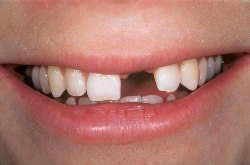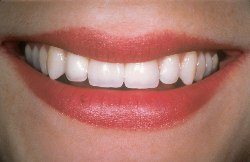Dental implants are becoming the option of choice for tooth replacement. They are the closest thing to a natural tooth. And they are getting more and more popular every year.
There are two main parts to a dental implant:
- A root form that is surgically placed in your jaw
- The replacement tooth that is placed on the root form.
Sometimes dental implants are used to support complete dentures. In those cases, the root form isn’t attached to a single tooth, but there may be anywhere from two to eight root forms that are used to anchor a denture.
Usually there is a healing period between the surgical placing of the dental implants and restoring them with replacement teeth. As technology and techniques improve, this healing period is shrinking. There is a highly sophisticated technique called Teeth in an Hour in which the teeth can be placed in the same appointment. Click the link to learn more.
As we said, having dental implants is the closest thing to having natural teeth. They function just like your own teeth.
And if the appearance of your teeth is important to you, and they are done by an expert cosmetic dentist, they will also look like natural teeth. Click here to find a cosmetic dentist. Click here to see smile makeover pictures of a dental implants case done by one of the cosmetic dentists in our referral network.
Properly placed and diligently maintained, they can last a lifetime. This means conscientious home care, and you need to regulary visit a dental hygienist who will remove tartar and other deposits. Lifespans of these restorations have increased greatly as technology has improved.
Advantages of Dental Implants over Other Tooth Replacement Techniques (such as fixed bridges or removable dentures):
- They look and feel like your own teeth. They are anchored in the bone the same as natural teeth.
- Their presence in the bone prevents the normal bone resorption that otherwise always occurs after teeth are missing. This jaw shrinking is a serious long-term problem for patients who have all their teeth extracted. It takes only about ten years for serious bone resorption to occur, which leads to shriveling of the face and the complete inability to wear or use a conventional removable denture.
- Done well by a true cosmetic dentist, no one will ever know that you have a false tooth.
- They don’t require any work on adjacent teeth. By contrast, a dental bridge requires preparing the adjacent teeth for crowns. Removable partial dentures require some grinding of adjacent teeth and the fitting of clasps and rests on them, which can catch food and promote tooth decay in those places.
- They build confidence. Since dental implants are permanently anchored in the bone, there is no risk of slippage, or losing or being caught without your teeth.
Disadvantages:
- They may be more expensive than other types of tooth replacement, and if there is extra cost it often won’t be covered by dental insurance.
- If you only have one or two missing teeth and if the teeth adjacent to those spaces already need dental crowns, there is less advantage to a dental implant.
- Extra visits are usually required, and you may have to see a specialist in addition to your regular dentist. The specialist (an oral surgeon or a periodontist) places the implant root form and your regular dentist places the crown, bridge, or denture on top of it. Some dentists, however, are trained in both procedures.
- There can be a healing delay of several weeks before you get your new tooth or teeth. However, some newer techniques (see Teeth-in-an-Hour) can give you your false tooth immediately, though these techniques may not be appropriate for your situation, may be too expensive for you, or your surgeon may not be experienced with them. In these cases, you will usually be given a temporary crown or a dental flipper to wear while you wait for your permanent teeth.
Click here to ask a question of a dentist about this topic.
Are You a Candidate for Dental Implants?
If you are in good oral and general health, you could be a candidate for this procedure. This means that you can tolerate the surgery.
You also need to have adequate bone present at the site of the missing teeth to support this device. In the absence of adequate bone, your surgeon can place bone grafts.
Pictures of dental implants work
We have photographs of dental implants from one of our mynewsmile.com network dentists. Look at them and see how real they look. We also have some photographs of a combination of implants and porcelain veneers from New Jersey cosmetic dentist Dr. Richard Champagne.
Here is a sample of the kind of work done by dentists in our referral network:
Cosmetic Considerations
If your missing tooth is in the front of your mouth and shows prominently when you smile, we recommend being seen by an expert cosmetic dentist. Cosmetic dental implants require special artistic training and ability that aren’t generally possessed by general dentists or prosthodontists. This case pictured just above is an excellent illustration of the kind of perfect match that only an expert cosmetic dentist can achieve.
Types of Dental Implants
Endosteal: This is by far the most common type. Endosteal means inside the bone. This type is placed within the bone rather than on top of it. Each implant can hold one or more false teeth.
Subperiosteal: These involve a metal framework that is placed on top of the bone with posts that poke through the gum to hold the false teeth, usually a full denture. These types are used for patients who had all their teeth extracted long ago so that their jaw has shrunk, making it difficult or impossible for them to wear a conventional denture. This is used very infrequently.
Other Treatment Options
If a tooth is broken at the gumline, it isn’t necessary to have it extracted. It may be possible to save this tooth, which eliminates the need for any replacement tooth. Click the link to read more.
For a single missing tooth, a dental bridge is another treatment choice.
For multiple missing teeth, a removable partial denture is a possibility.
If all your teeth are missing, you can have a complete removable denture, but shrinkage of the jaw with facial collapse is an inevitable result of this treatment option.


